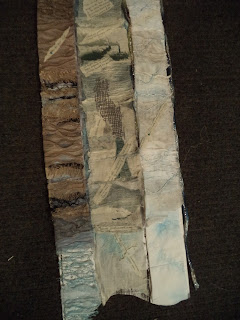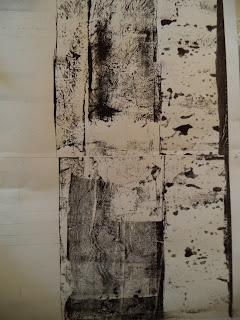Started Design work 5/2/16 completed 29/2/16 Number of hours: 48 1/4 hours
Started Embroidery work 1/3/16 completed 20/3/16 Number of hours: 42 1/4 hours
Costing of Design and embroidery work for wall hanging
Item Supplier Cost of item Amount used Estimated Cost
Design
Pinboards Charity shop 1.00 each all 2.00
Toner Amazon 25.00 all 25.00
Black card The Works 1.50 half 7.50
Glue Stermat 1.00 for 3 half of 1 0.15
Notebook " 1.00 all 1.00
Pencils/pastels/felt tips in stock N/A
Blue/Green gel pens 2.15 each 10% 0.42
Black Stermat 1.99 1.99
Sharpie The Works 1.99 1.99
Coloured papers in stock N/A
Tissue paper 3 sheets 0.75 £44.05
Sandra Meech book in stock N/A
Print blocks in stock 2.00
Print block tools (pkt) in stock 8.95
Acrylic paints x6 Alpha Business 4.99 10% 3.00
Acrylics x" The Works 3.00 10% 0.60
Tissue papers 1.99 50% 1.00
Bubble wrap in stock free N/A
Black paper The Works 1.00 pkt all 1.00
White card 1.00
A3 cartridge paper Amazon 8.00/100 12 0.50
Gesso acrylic 4.99/500ml 0.5% 0.25
Transparent
material in stock N/A
Glue Stick Stermat 1.00 for 3 1 0.33
Fabric conditioner to use with fabric in stock for printing third 0.70
Friends equipment with no cost £19.33
Embroidery
Item Supplier Cost of item Amount used Estimated Cost
Cartridge paper Amazon 8.00/100 10 sheets 0.45
Acetate and tissue A4x2 0.40
Layer 1 fabrics and threads
Layer 2 fabrics and threads
Layer 3 Fabrics and threads see below
Because the wording and columns are disrupted when published on to the Blog I have decided to scan written sheets
Embroidery costs

Total Costings for design work £63.38
Total Costings for Embroidery work £42.50
Health and Safety rules observed
Here is a list of the items and working processes that have been used in Module 6, requiring special care and attention to protect myself, my environment and own work
All materials and equipment should be kept out of reach of children
Using bleach:
- Don't work in a confined space, keeping windows open in order to avoid breathing in fumes
- Use gloves to protect hands
- Store bleach with a secure lid
- Keep sharp scissors out of reach of children
- Hold carefully using handles
- Keep blades covered using shield supplied when not in use
- Use metal rulers with ridges to protect fingers
- Use proper cutting mat to avoid damage to surfaces
- If necessary tape down material to be cut so able to cut accurately
- Keep sharp scissors out of reach of children
- Keep needles sewn into fabric when not in use, or in appropriate container or needle case
- Keep machine in good order
- Ensure flex does not cause trip hazard
- Ensure seating provides good posture when using the machine
- Switch off when changing needles or lower spool
- For cable stitch use an extra adjusted spool case to avoid damage to needles and to work stitching
- Store threads in lidded container or tray when in use
- Ensure heated end of soldering iron is in a heat proof container (eg upturned flower pot)
- Take care in use, holding insulated handle only
- Ensure flex does not cause trip hazard or will not knock over items when in use
- Ensure hands are dry when switching on and off at plug
- Use in a well ventilated room and if necessary use a mask, dependent on fabric
- Use a glass sheet underneath the work to protect surfaces, edged with masking tape to avoid cuts from glass
- Use plastic surface under work to protect surfaces from spillage
- Use in a well ventilated room and if necessary use a mask. especially if using powders to protect lungs against fine particles
- Keep mixed dyes, salt and soda solutions in carefully sealed containers with non-metal lids and label contents
- Use gloves to protect hands
- Keep liquids away from electrical points
- Ensure flex does not cause trip hazard
- Keep iron on heat resistant surface or resting upwards to avoid burns and fire
- Switch off when not in regular use
- Ensure use the correct heat setting dependent on fabric or embroidery technique in use
- Use parchment paper to avoid damaging the iron, on some occasions both underneath and top of work
Below is a signed document by a fellow embroiderer to confirm that all the work carried out in Module 6 was completed by Linda Beagan























































